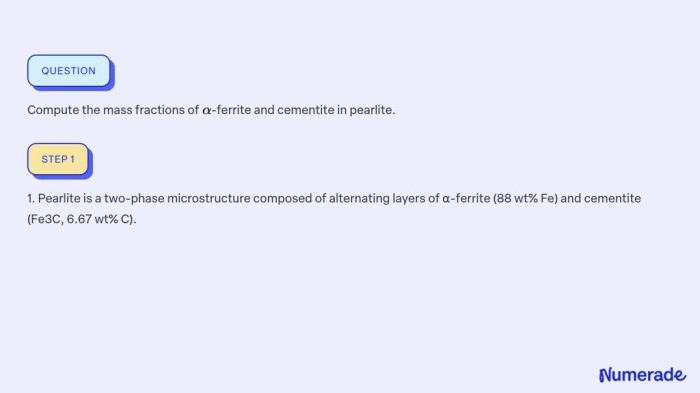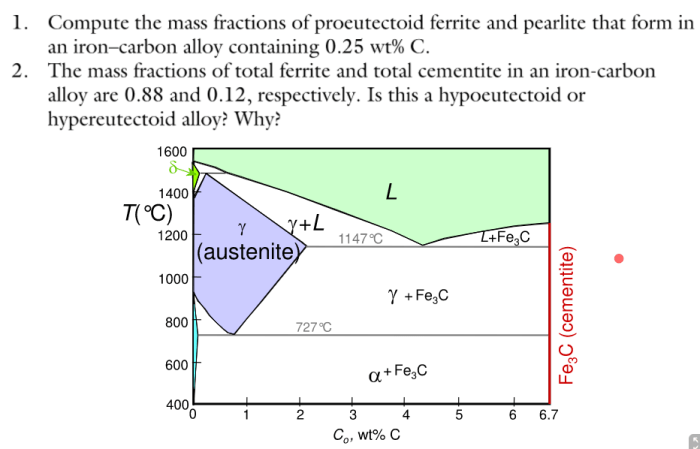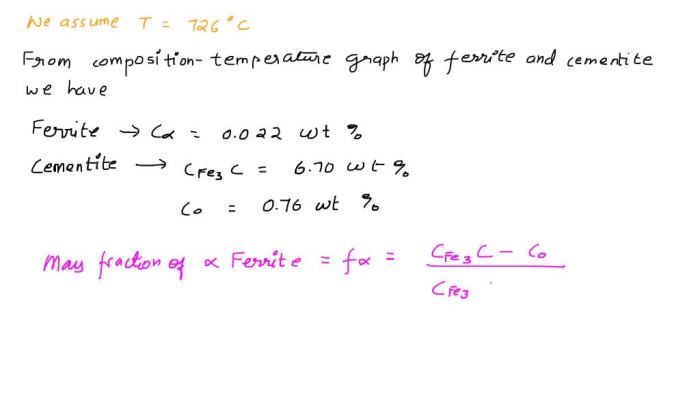Compute the mass fractions of ferrite and cementite in pearlite. – As we embark on the intricate analysis of pearlite, a cornerstone of steel microstructures, we delve into the fascinating realm of mass fraction analysis. This exploration unravels the enigmatic relationship between ferrite and cementite, unlocking a deeper understanding of material properties and engineering applications.
Pearlite, a ubiquitous constituent in steel, exhibits a unique microstructure characterized by alternating lamellae of ferrite and cementite. Understanding the mass fractions of these phases is paramount in deciphering the mechanical and physical properties of steel.
Introduction
Pearlite is a two-phase microstructure consisting of alternating layers of ferrite and cementite. It is the most common microstructure in steels and plays a crucial role in determining their properties.
Mass Fraction of Ferrite

Mass fraction is the ratio of the mass of a particular phase to the total mass of the material. In pearlite, the mass fraction of ferrite (Mf) can be calculated using the following formula:
Mf = (ρf
- Vf) / (ρf
- Vf + ρc
- Vc)
where ρf and ρc are the densities of ferrite and cementite, respectively, and Vf and Vc are their respective volume fractions.
The mass fraction of ferrite is influenced by factors such as alloy composition and cooling rate.
Mass Fraction of Cementite: Compute The Mass Fractions Of Ferrite And Cementite In Pearlite.

The mass fraction of cementite (Mc) can be calculated using a similar formula:
Mc = (ρc
- Vc) / (ρf
- Vf + ρc
- Vc)
Factors that influence the mass fraction of cementite include alloy composition and cooling rate.
Relationship between Ferrite and Cementite Mass Fractions
The mass fractions of ferrite and cementite in pearlite are related by the following equation:
Mf + Mc = 1
This equation indicates that the mass fractions of the two phases must sum up to unity.
Applications of Mass Fraction Analysis

Mass fraction analysis is widely used in materials science and engineering to determine the composition and properties of materials. In the case of pearlite, mass fraction analysis is crucial for understanding its mechanical properties and optimizing its performance in various applications.
Top FAQs
What is the significance of mass fraction analysis in understanding pearlite?
Mass fraction analysis quantifies the relative amounts of ferrite and cementite in pearlite, enabling researchers to correlate these fractions with the material’s mechanical properties, such as hardness and strength.
How does cooling rate influence the mass fractions of ferrite and cementite?
Cooling rate plays a crucial role in determining the mass fractions of ferrite and cementite. Rapid cooling promotes the formation of ferrite, while slower cooling favors cementite precipitation.
What are the practical applications of mass fraction analysis in the steel industry?
Mass fraction analysis is widely used in the steel industry to optimize the properties of steel for specific applications. By controlling the mass fractions of ferrite and cementite, manufacturers can tailor the strength, toughness, and wear resistance of steel components.